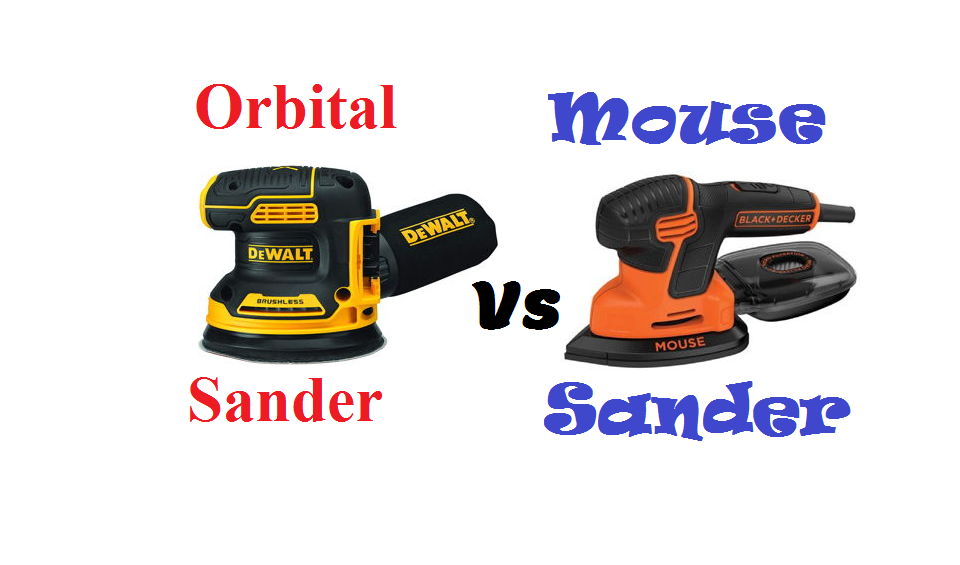As an Amazon affiliate, we earn a commision from qualifying purchases.
Our orbital sander vs mouse sander matchup will help you make the right decision when shopping for a sander.
If you’re shopping for a sander for your projects, it’s important to select the right tool for the job.
Now, most newbies have problems choosing between an orbital sander and mouse sanders and often end up making the wrong choice.
Don’t make the same mistake: here is our orbital sander vs mouse sander comparison article to help point you in the right direction.
Let’s go straight to the point:
Orbital sander vs mouse sander – the basics
First, note that an orbital sander features a square-shaped sanding pad and sands by vibrating the foot rapidly in tiny circles/orbits.
And while they are not overly aggressive meaning it’s more difficult to strip large amounts of material with orbital sanders, the tool leaves a high-quality finish
On the other hand, the mouse sander features a triangular-shaped head – you attach sandpaper to the small head to sand.
That said, mouse sanders are inventive tools and some accept loads of attachments including hardened rubber “bits” (in various shapes and sizes) to help you tackle specific applications.
For example, when you wrap the bits with special self-adhesive sandpaper, the mouse sander makes short work of extraordinarily tight spots and corners.
Orbital sander vs mouse sander – the differences
The biggest difference between the two devices is the design:
First, as indicated earlier, the orbital sander features a square sanding base while the “mouse” comes with a small, triangular-shaped sanding base (some says it resembles a clothes iron).
The next notable distinction is the sanding action: as alluded to above, orbital sanders operate in a circular/orbital action.
In contrast, the sanding action in mouse sanders can be oscillating – the pad rocks forward/backward in a somewhat short arc- or orbital (rotating in small circles).
Perhaps I should add that orbital sanders generally accept 1/4 of a typical 9-in x11-in sheet of sandpaper.
Subsequently, some users have nicknamed these tools quarter-sheet sanders (the market also offers half-sheet orbital sanders).
Keep in mind that for mouse sanders, you attach triangular sanding discs using the easy hook-and-loop system for most brands.
What is a mouse sander best used for?
The peculiarly shaped pad in this sander helps it to reach inside crevices, small corners, and other tight spaces.
For this reason, the sander is used frequently to sand odd shapes, seams, corners, and most of the extremely small and tight spots.
That explains why the tool sometimes goes by names such as corner sander/detail sander/triangle sander.
Here are examples of jobs that a mouse sander suits:
- Refinishing furniture and various intricate projects including sanding intricate molding.
- Finishing cabinets/doors.
- Crafting projects.
What jobs is the orbital sander ideal for?
While the “mouse” is a godsend for fine finishing around the most hard-to-reach spaces, the orbital sander is mostly used for fine finishing sanding on large surfaces or light sanding jobs (where not much material needs to be stripped).
Remember:
The square foot of these sanders still allows the tool to get inside crazy corners and sand sharp edges.
However, compared to the mouse sander, orbital sander struggles more to get inside the most challenging spots.
Here are examples of jobs that an orbital sander would be ideal for:
- Prepping surfaces for painting/sealing.
- Knocking down a coat of paint (but it’s slower for jobs that require complete removal of entire layers).
- Refinishing wood floors.
In a nutshell, this is the best tool for general light sanding jobs and between layers of paint or other types of finishes.
Orbital sander vs mouse sander (orbital sander or mouse sander)- similarities
In essence, a mouse sander is really a variation of orbital sanders- the two are, first off, finishing sanders.
Perhaps more noteworthy, the two get into stressful spaces more easily though the “mouse” is more precise inside corners and rough edges.
In addition, the two shares one major drawback: compared to random-orbit sanders, they often leave more noticeable swirl marks.
You see, because a random-orbit sander makes two separate motions when sanding- circular and back and forth- the sanding marks are less obvious making it more ideal for extra- or superfine work.
Its, however, worth mentioning that random-orbit sanders won’t fit in hard-to-sand spaces because of the round sanding pad.
Side Note: For woodworking, an orbital sander is typically most effective when you move it with the grain (of the wood).
Orbital sander vs detail sander – pros and cons
So, what are the distinct upsides and downsides of each tool?
Here is a summary of the advantages and disadvantages of using each type of sander:
Orbital sander – pros
- Better for sanding large surfaces.
- Not very aggressive so it won’t damage timber, plaster, or previously painted surface.
Orbital sander – cons
- Not capable of removing thick layers of paint, varnish, and other materials quickly- it loses out to belt or random orbital sander.
Mouse sander – pros
- A joy to use on the hardest-to-reach spaces.
- Works with tons of attachments for more fine results when sanding right into super tight corners/crevices.
Mouse sander – cons
- Not suitable for large scale jobs- best corners, crevices, and edges.
Wrapping it up
To sum up, there’s no one size fits all approach when it comes to sanders – truth be told, there are countless other options in sanding.
For example, if you want to sand large surfaces fast, a belt (or even a random orbital sander) works best.
So, for the purpose of this orbital sander vs mouse sander matchup, you should make a list of all your unique requirements and pick the tool that best meets them depending on the projects you have at hand.
The good thing is that you can always rent the tool you won’t buy for sanding projects you need to use it.

